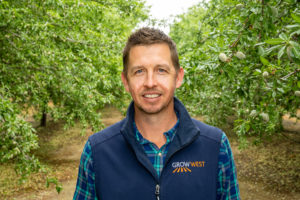Growing Together Spring 2022
2022 Crop Protection and Fertility Outlook: Navigating Broken Supply Chains
The “long tail” of COVID-19, domestic and global logistical problems, and overseas conflict all contribute to massive challenges for growers in securing fertilizer and crop protection products. The good news is there are steps you can take to make sure you have what you need — or close to it. And the Grow West team is ready to help make that happen whenever possible.
“From the 30,000-foot view, it’s as challenging a market as it’s ever been,” said Grow West Director of Procurement and Supplier Relations Robbie Malm. “It’s as tough an environment as I’ve seen in my career.”

Adding to the list of challenges facing growers is strong nationwide demand — especially for fertilizer — and crop prices that incentivize acreage expansion in other parts of the country. This means even more price pressure for growers and retailers in the western U.S. like Grow West.
“Shifts in broad-acre crops around the country are huge when you start looking at supply chains and our ability to serve each acre,” said Grow West Vice President and Chief Operating Officer Lucas Schmidt. “Major price moves in broadacre crops like corn and wheat will continue to pressure product supply. Nobody probably saw that in forecasting product availability, and when you throw in all the global dynamics on top of what’s happening around the country, it’s no wonder we’re in this situation. It shows the just-in-time buying model doesn’t work anymore.”

The influence of changing market behaviors
A shift away from that just-in-time buying is fundamental to weathering the current supply and cost storm. While retailers are planning further ahead to manage supplies, it’s not an overnight process; even when making such changes at the local level, there are no guarantees that they’ll translate into improved product availability anytime soon.
“We’re seeing changing behavior among retailers and growers alike. Those with storage and financial means are taking positions on inventory sooner than ever before. More suppliers are looking 90 to 120 days out versus 30 days,” Malm said. “The problem is on the production and logistics sides. It might take a product manufactured overseas 75 days to arrive, so that doesn’t leave a lot of time to catch up. The supply chain is fundamentally broken, but we can meet product needs when people can take positions earlier and plan further ahead.”
Schmidt and Malm know the impact these challenges have on growers. Rocketing costs and ongoing challenges like drought and labor make crop protection product and fertilizer prices and availability like pouring salt on an open wound. But despite supply disruptions — with some deliveries happening months after an order is placed — there are things growers can do to help work through the current situation.
Communicate early and often to avoid product logjams
Good communication and staying on top of news influencing crop protection markets are part of that effort. By staying informed on crop protection product and fertilizer price trends and the events influencing them, growers and retailers can make informed purchase decisions and stay ahead of expected price hikes. It’s a process that involves good communication between growers and ag retailers.
“I think everyone needs to be honest up-front, and if we can’t deliver, we need to share that. We need to prove to customers that we can deliver them products and information proactively and help them solve their supply situations now,” Schmidt said. “And if we can’t, we better be up-front and eliminate surprises where we can.”
With the quickness of today’s news cycle, it’s also important to avoid knee-jerk reactions to stories that may or may not influence the crop protection and fertilizer markets. Some issues do fundamentally impact prices while others are more a function of quick reactions that cause immediate fluctuations but may not foreshadow new trends.
“There’s a lot of reactivity today. Especially when we see record valuations for some products, it’s natural to react quickly and be jumpy,” Malm said. “Some issues like COVID-related disruptions and geopolitical issues overseas do have real impacts on the market. It’s important to know what is fundamentally important in making smart decisions.”
Make alternate plans and consider long-term changes
A close look at product prices shows varied reactions to marketplace disruptions. Products like glyphosate and glufosinate herbicides, for example, are widely used, so it’s a good idea to make sure you’ve got adequate supplies in place given the potential for broad demand spikes to influence prices down the road.
“These are high-use, high-demand and ubiquitous products. Since they’re the highest-volume products, we want to make sure we have a rolling 90 to 120-day forecast of those products and keep a ‘safety stock,’ so to speak,” Malm said. “Forecasting is an art form, not a science, and we have to make decisions based on the best information we have at any given time.”
Bearing specific product availability in mind, Malm recommends growers do their homework and prepare for anything they may need to apply throughout the year and communicate those needs to your ag retail partner. Then, be adaptable; create backup plans in the event your first-choice products aren’t available.
“I think it will be important to stay in constant communication with your local Grow West team and ideally, your PCA,” Malm said. “Have your ‘A’ strategy in place, then have contingencies — a Plan B, C and maybe even D. Being aligned, flexible and having contingency plans are important in a volatile market like today.”
Beyond meeting crop protection and fertilizer needs in the short term, Malm recommends considering longer-term changes you can make to your operation to shift away from high-demand products that may be in short supply well into the future. Adjusting production systems and being open to new or different options can help avoid falling into a logistical trap down the road.
“We no longer live in a world where supplies for some common products are unlimited or infinitely available. If you plan to use a fall burndown herbicide like glyphosate in your spring weed management program, for example, consider applying other pre-emergent herbicides in the winter months,” Malm said. “Develop that consultative relationship with your PCA and local Grow West team and formulate plans. Ask yourself ‘What am I trying to accomplish on my operation?’ Answering that question may show you can do things differently with the same results. But it can only happen with resilience and a strong relationship with your retailer team.”
